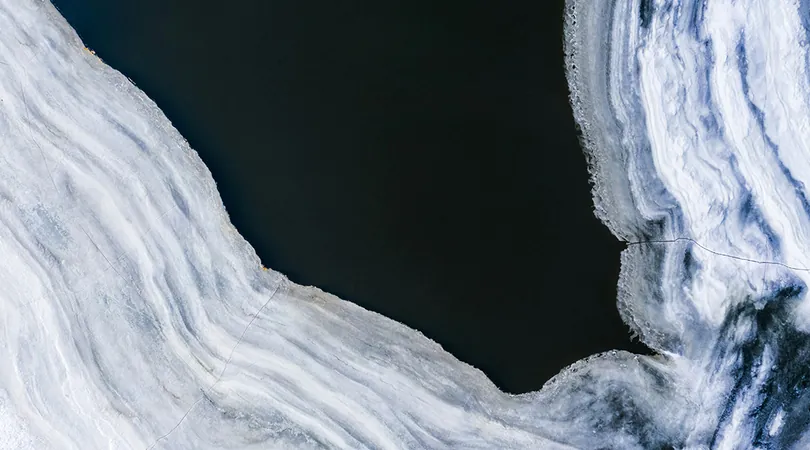
The Shocking Collapse of Antarctica’s Conger-Glenzer Ice Shelf: A Wake-Up Call for Global Sea Levels
2025-01-10
Author: Mei
The Collapse of the Conger-Glenzer Ice Shelf
In March 2022, a significant and alarming event occurred in East Antarctica as the Conger–Glenzer Ice Shelf disintegrated within just nine days. Once deemed stable and protective of the ice sheet behind it, this ice shelf's collapse marks the first recorded incident of its kind in East Antarctica, igniting fears of potential sea-level rise associated with this lesser-studied region of the continent.
Recent investigations into 25 years of satellite imagery have provided researchers with critical insights into the causes of this unexpected collapse. The ultimate goal is to understand this event better and its implications for future ice shelf failures, which could drastically impact global sea levels.
Helen Fricker, a researcher at the University of California, San Diego, emphasized the significance of this incident: “East Antarctica was once considered stable, and this event challenges that assumption. The East Antarctic Ice Sheet holds enough ice to raise global sea levels by a staggering 58 meters if it were to melt completely—18 times the volume of the Western Antarctic Ice Sheet.” She explained that ice shelves serve as vital barriers that prevent the inland ice from flowing into the ocean, and their collapse can accelerate this flow, contributing to rising sea levels.
Understanding Ice Shelves: Why They Matter
Ice shelves are massive platforms of ice formed where glaciers or ice sheets flow into the ocean, extending out and floating on seawater. These structures, which constitute nearly two-thirds of Antarctica's coast, play an essential role in buttressing the Antarctic ice sheet. As they thin, retreat, or break apart into icebergs, the underlying ice sheet is exposed, leading to increased melting and the potential for catastrophic collapse.
Historically, ice shelf collapses captured in satellite records have predominantly occurred in the Western Antarctic Ice Sheet. However, the Conger-Glenzer Ice Shelf's recent failure indicates a disturbing shift in how these structures might respond to climate change, moving from surface melt processes to ocean-driven motives.
What Research Reveals: The Timeline of Collapse
Fricker and her research team meticulously analyzed satellite data and ocean temperature records to document the changes in the Conger-Glenzer Ice Shelf over 25 years. They noted four distinct stages of retreat, outlining how the ice shelf's approximate 1,200 square kilometers surface area has shifted over time.
Initially, in the early 1990s, the shelf had a thickness of about 200 meters. However, the period between 1997 and 2000 saw a loss of 85 square kilometers as it separated from the extensive Shackleton Ice Shelf. The ice sheet continued to recede, losing 10% of its surface area between 2000 and 2011, and by 2011, it no longer clung to underlying rock formations that had previously stabilized it—a critical tipping point.
From 2012 to 2019, while the rate of calving slowed down, thinning continued. Notably, during the final stage, the shelf collapsed dramatically in March 2022, losing substantial thickness and mass as it was increasingly exposed to warmer ocean waters. This event, while expedited by a powerful atmospheric river in the area, was primarily due to decades of evolutionary processes.
A Call to Action: The Urgency of Research
The implications of these findings are profound. The Conger-Glenzer Ice Shelf's collapse serves as a stark reminder of the rapid changes occurring in polar regions, far faster than current models predict. Coauthor Catherine Walker, from the Woods Hole Oceanographic Institution, highlighted these uncertainties, stating that continued research is essential for accurately forecasting sea-level rise and its effects on global communities.
These alarming developments resonate beyond just scientific circles; they call for urgent climate action and continuous monitoring of these vital ecosystems. “While some future changes are already 'baked in,' we must strive to limit future impacts,” Walker concluded.
As we delve deeper into the complexities of climate change, the time to act is now. The disintegration of the Conger-Glenzer Ice Shelf underscores the vulnerability of our planet's ice reserves and the looming threat to coastal regions around the world. Understanding and addressing these changes is critical to ensuring a sustainable future for all.
 Brasil (PT)
Brasil (PT)
 Canada (EN)
Canada (EN)
 Chile (ES)
Chile (ES)
 Česko (CS)
Česko (CS)
 대한민국 (KO)
대한민국 (KO)
 España (ES)
España (ES)
 France (FR)
France (FR)
 Hong Kong (EN)
Hong Kong (EN)
 Italia (IT)
Italia (IT)
 日本 (JA)
日本 (JA)
 Magyarország (HU)
Magyarország (HU)
 Norge (NO)
Norge (NO)
 Polska (PL)
Polska (PL)
 Schweiz (DE)
Schweiz (DE)
 Singapore (EN)
Singapore (EN)
 Sverige (SV)
Sverige (SV)
 Suomi (FI)
Suomi (FI)
 Türkiye (TR)
Türkiye (TR)
 الإمارات العربية المتحدة (AR)
الإمارات العربية المتحدة (AR)